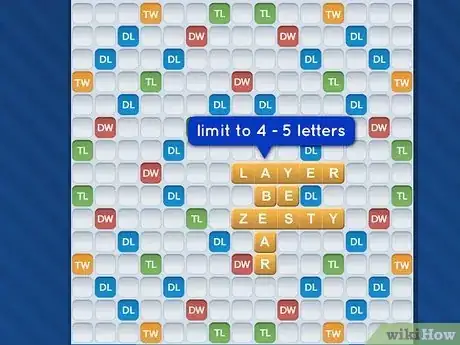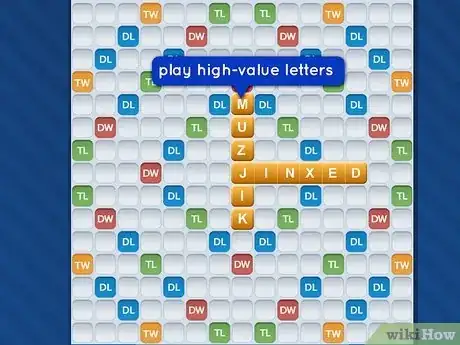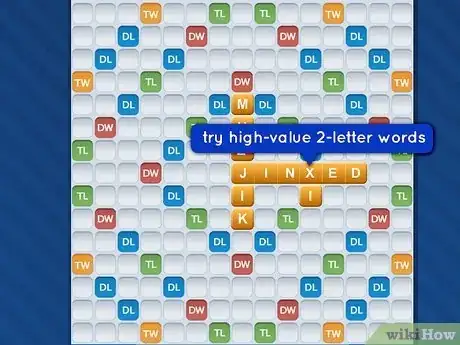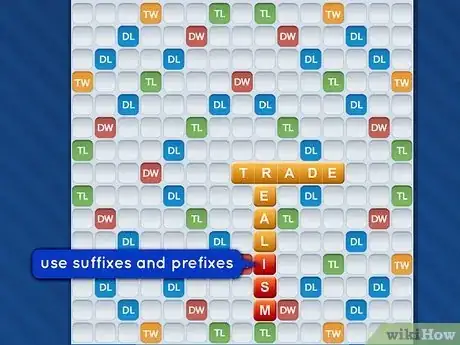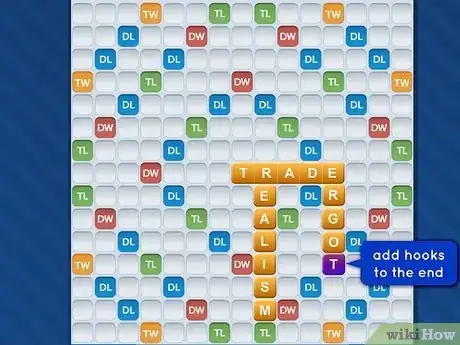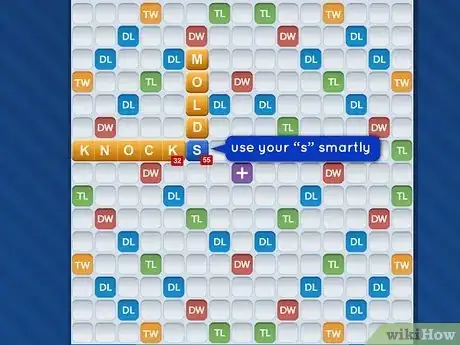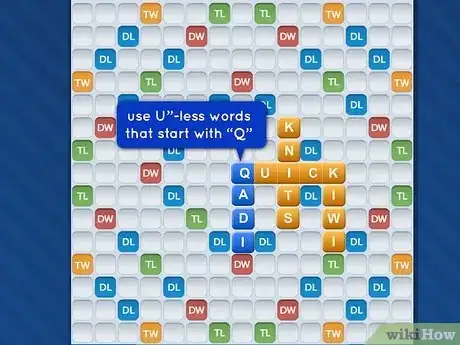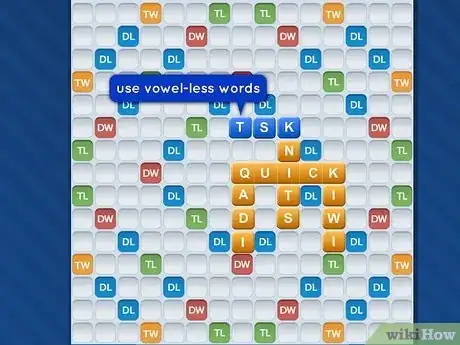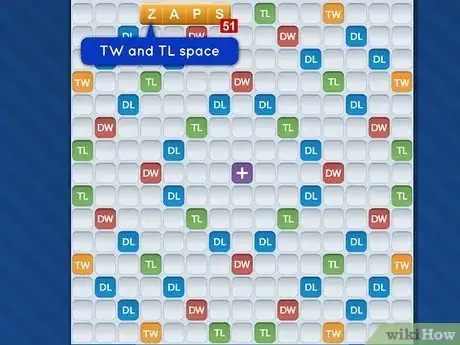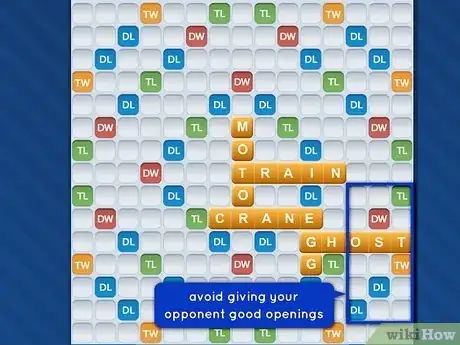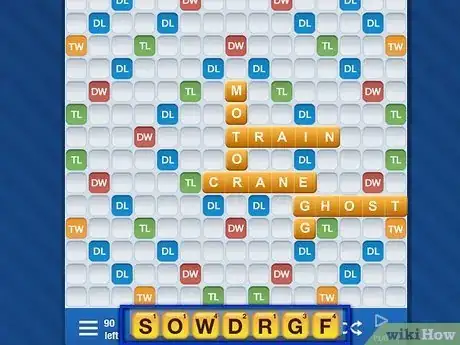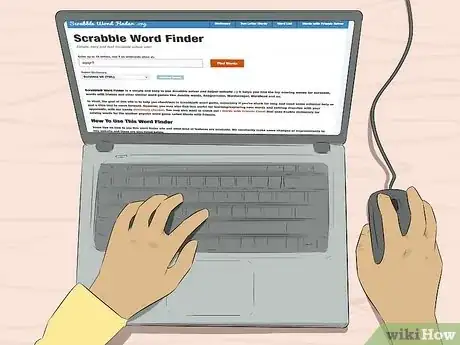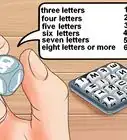This article was co-authored by wikiHow staff writer, Janice Tieperman. Janice is a professional and creative writer who has worked at wikiHow since 2019. With both a B.A. and M.A. in English from East Stroudsburg University, she has a passion for writing a wide variety of content for anyone and everyone. In her free time, you can find her working on a new crochet pattern, listening to true crime podcasts, or tackling a new creative writing project.
There are 11 references cited in this article, which can be found at the bottom of the page.
This article has been viewed 13,941 times.
Learn more...
Ah, Words With Friends (WWF)... it’s all fun and games until your opponent sticks an “X” tile on the triple-word space. How are you supposed to get the upper hand in all of your match-ups and come out on top? There’s no need to worry—we’ve put together plenty of tips, tricks, and strategies to help you win at WWF. How many points is the word “victory” worth, again?
Steps
Arrange words in parallel lines.
-
Parallel words make it easy to set up high-value combos. As the game starts, commit to playing your first few words in either horizontal or vertical lines. That way, you can create new words by intersecting letter tiles with existing rows or columns.[1] X Research source
- If you played the words “LAYER” and “ZESTY” 2 rows apart horizontally, you could play the word “YES” between the central letters on a future turn.
- Playing in parallels can also help you control the board better, since it prevents your opponent from playing longer words.[2] X Research source
Limit most words to 4 or 5 letters.
-
Shorter words keep gameplay in the center of the board. Long words are great, but they create lots of opportunities for your opponent to scoop up double and triple bonuses, which are found toward the outside of the board. Short, 4- or 5-letter words help keep gameplay centralized, and help you better control the point margins.[3] X Research source
Play high-value letters strategically.
-
Letters like “X” and “J” aren’t a handicap—they’re your secret weapon! Look for strategic ways to fit these high-value letters into your future plays, using what’s on the board as a starting point. For an even bigger bonus, memorize words that have multiple high-value letters in them, like:[4] X Research source
- X and J: JINXED, JUKEBOX, JINX
- X and Z: ZAX, ZAXES, OXIDIZE
- Z and J: JEEZ, JAZZ, MUZJIK
- “J,” “Q,” and “Z” are worth 10 points, and are the most valuable tiles in the game. “X” is a close runner-up, and is worth 8 points.[5] X Research source
Use high-value, 2-letter words.
-
Maximize point value using as few letters as possible. Word length doesn’t matter in WWF—it’s the point value that counts. 2-letter words can pack a big punch when they include high-value consonants. These short words are easy to tack onto existing words; plus, they can get you a whole lot of points if you arrange them over the right power-up spaces. Try words like:[6] X Research source
- QI
- XI
- JA
- JO
Build off “R” if you have tons of vowels.
-
Having a hand full of As, Es, Is, and Os can feel pretty helpless. Inspect the game board for any “R” tiles in play that could possibly be transformed into a new word. There are plenty of vowel-heavy words that only have a single “R” in them, like:
- ARIA
- AERIE
- UREA
- EERIE[7] X Research source
Extend words with suffixes and prefixes.
-
Why make your own word when you can just use your opponent’s? Maybe your opponent played the word “BOX” to capitalize on the “X” letter bonus. Transform their play into even more points by adding a prefix or suffix to the word, like “UN-,” “-ED,” “-ER,” or “-ES.” Prefixes and suffixes are a great way to turn your opponent’s own gameplay against them![8] X Research source
- Prefixes: A-, AN-, CO-, DIS-, EX-, IN-, NON-, POST-, PRE-, UP-
- Suffixes: -ACY, -AL, -ISM, -IST, -MENT, -SHIP, -SION/TION
Add hooks to the end of existing words.
-
Hooks are single letters that can be tacked on to the end of words that are in play. Take words like “BOSS,” “ERGO,” “CHIN,” “CURE,” and “ACHE”—they all can stand on their own, but they all can be turned into more powerful, high-value words.[9] X Research source Take a closer look:
- “BOSS” + “Y” = BOSSY (originally worth 7 points, now worth 10 points)
- “ERGO” + “T” = ERGOT (originally worth 6 points, now worth 7 points)
- “CHIN” + “E” = CHINE (originally worth 10 points, now worth 11 points)
- “CURE” + “R” = CURER (originally worth 8 points, now worth 9 points)
- “ACHE” + “D” = ACHED (originally worth 9 points, now worth 11 points)
- Note: These point calculations only factor in the base value of the tiles. With power-up spaces like DL, TL, DW, and TW, hooks have limitless potential to net you more points.
Save your “S” letter tiles.
-
These versatile tiles can build into or create countless valuable words. Letter “S” tiles are really easy to tack onto existing words, giving you the entire point value of that word (plus the “S”!), along with the point value of the new word you created.[10] X Research source
- Maybe your friend played “KNOCK” horizontally from a TL to a DL space, earning them a whopping 32 points. Create a totally new word like “MOLDS,” sticking the “S” at the end of “KNOCK” and building your new word vertically. Not only will you get 33 points from “KNOCKS,” you’ll also get points for playing “MOLDS”!
Memorize “U”-less words that start with “Q.”
-
A well-placed “Q” tile can easily put you in the lead. There are plenty of WWF-permissible words that include “QI,” “QA,” or other non-QU combos. The next time you get a “Q” in your hand, try playing one of these words:[11] X Research source
- QOPH
- QWERTY
- QADI
- QAT
Learn a few vowel-less words.
-
Be prepared in case you’re running low on vowels. Words like “CRYPT,” “RHYTHM,” and “SCRY” have got you covered.[12] X Research source WWF even accepts some onomatopoeia words, like “HMM,” “BRR,” and “SHH.” Here are a few other words you can commit to memory for later:
- PFFT
- PSST
- TSK
- CRWTH(S)[13] X Research source
Go for triple-word bonuses.
-
A triple-word bonus helps you build a bigger lead than a double one. There are 3 different kinds of bonuses that are close to the center of the board: DW (Double Word), DL (Double Letter), and TL (Triple Letter). These bonuses are pretty good, but they’re nothing compared to the TW (Triple Word) bonus, which is found 8 total times toward the 4 outer corners of the board. Whenever possible, snag a TW combo to really amp up your score.[14] X Research source
- For example, the word “ZAPS” could earn you 34 points when played between a DW and TL space, but could earn you 51 points when played between a TW and TL space.
- Be strategic with TW spaces, though! Don’t play a word on a TW tile if it gives your opponent easy access to the exact same power-up.
Block off your opponent’s openings.
-
WWF is as much of a defensive game as it is an offensive one. Keep a close eye on the power-up squares near the new words that you play. Does your new word give your opponent a free shot at a TW space, or does it block them off from any good opportunities? Always play with your opponent’s score in mind, rather than your own score.[15] X Research source
- For instance, you wouldn’t want to play the word “GHOST” right next to a TW square. Your opponent could easily tack on an “-S” and pick up the triple-word bonus!
Check the tile bag.
-
The game’s built-in “tile bag” feature helps you weigh your options. Think of the tile bag as a snapshot of the letters that currently are and aren’t in play. Not sure if your opponent is going to surprise you with a high-value letter like “J,” “Q,” or “Z”? Pull open the “tile bag” built into your game and see what tiles haven’t been played yet.[16] X Research source
- For instance, there is only 1 “Q” tile given out in a single WWF game. If you don’t have a “Q,” there’s no “Q” played on the board, and there’s no “Q” in the tile bag, you can assume that your opponent might have a high-value word/combo up their sleeve in an upcoming turn.
- The tile bag can also help you brainstorm potential words to play in future turns. If you’d like to play the word “FAXES” but are missing an “S” tile, check the tile bag and see how many “S” tiles are leftover. If there are a lot of “S” tiles left in the bag, there’s a good chance you might pick one up during your next turn.
- Just keep in mind that your opponent can use this feature, too!
Overlay your game with a cheating program.
-
This isn’t super ethical, but it pretty much guarantees you the win. Cheating programs like “Words Cheat” process information from your current WWF game, like the letters you have, and suggest high-value words that you can play. Some apps even analyze the letters/words that are currently in play on the game board.[17] X Research source
- Android Cheating Apps: Words With Friends Cheat (by Scabby Apps) and Word Breaker (by Firecracker Software)
- iOS Cheating Apps: Cheat for Words With Friends and Cheat Master for Words Friends
- For less overt cheating, pull up a word finder site like https://scrabblewordfinder.org/ to see which words you can make with the tiles in your hand.
- Take a little extra time to make your play if you’re using a cheating program. If you keep playing high-value words in a really short span of time, your opponent may start to catch onto your wily ways.
You Might Also Like
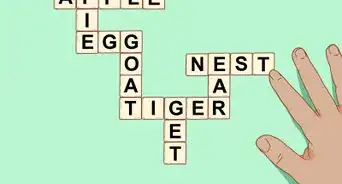 How to Set Up and Play Bananagrams
How to Set Up and Play Bananagrams
 Beat Wordle Every Time: The Best 5-Letter Words & Tricks
Beat Wordle Every Time: The Best 5-Letter Words & Tricks



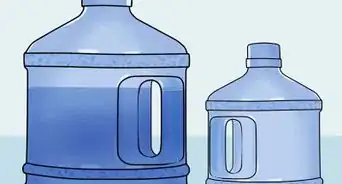


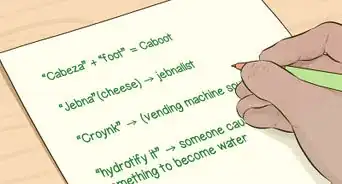

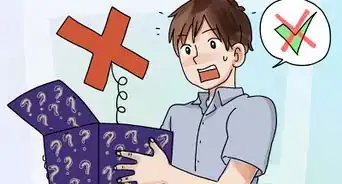

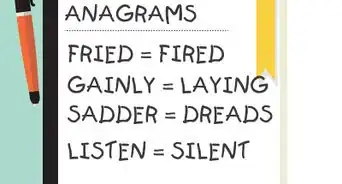
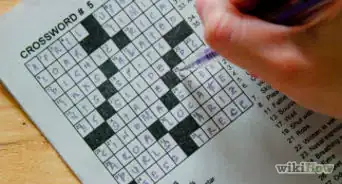
References
- ↑ https://scrabblewordfinder.org/tips-to-win-at-scrabble
- ↑ https://www.goodhousekeeping.com/life/entertainment/g19731948/scrabble-tricks/
- ↑ https://11points.com/analytics-found-ultimate-scrabble-strategy-not-thought/
- ↑ https://scrabblewordfinder.org/tips-to-win-at-scrabble
- ↑ https://www.wordunscramble.io/articles/words-with-friends-letter-values
- ↑ https://www.popularmechanics.com/culture/gaming/a29329172/scrabble-tips/
- ↑ https://www.goodhousekeeping.com/life/entertainment/g19731948/scrabble-tricks/
- ↑ https://www.goodhousekeeping.com/life/entertainment/g19731948/scrabble-tricks/
- ↑ https://www.businessinsider.com/scrabble-tips-and-tricks-2014-4
- ↑ https://wordunscrambler.me/5-tips-to-score-better-in-wwf
- ↑ https://www.goodhousekeeping.com/life/entertainment/g19731948/scrabble-tricks/
- ↑ https://scrabblewordfinder.org/tips-to-win-at-scrabble
- ↑ https://www.mentalfloss.com/article/28926/17-vowel-free-words-acceptable-words-friends
- ↑ https://zyngasupport.helpshift.com/hc/en/63-words-with-friends-2/faq/10539-how-do-i-earn-points/
- ↑ https://www.businessinsider.com/scrabble-tips-biggest-mistakes-2019-2#2-they-think-the-best-play-is-the-one-that-scores-the-most-points-2
- ↑ https://wordunscrambler.me/5-tips-to-score-better-in-wwf
- ↑ https://www.youtube.com/watch?v=jM7vaRB7vi4&t=0m11s
About This Article


